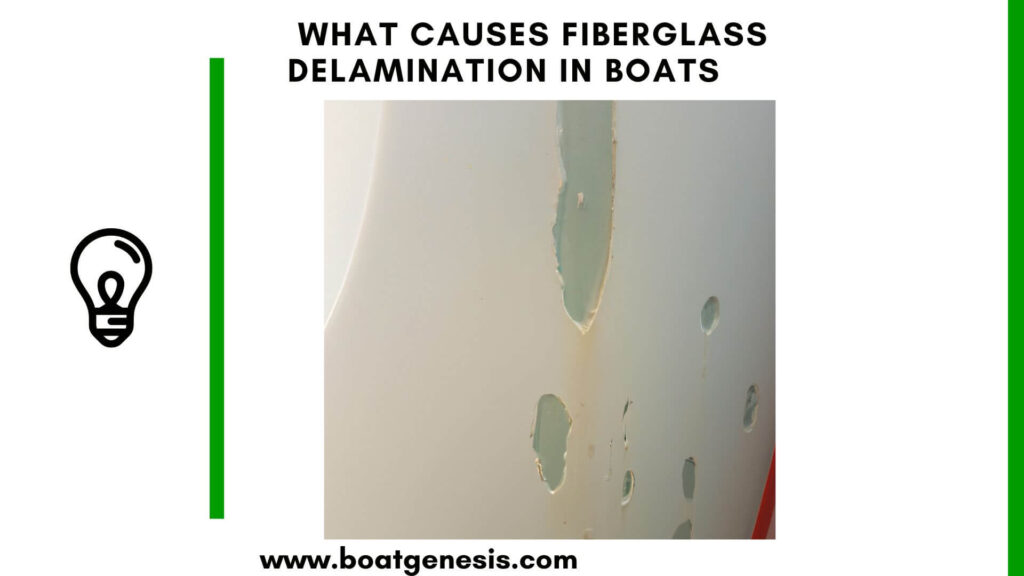Have you ever run your hands over the hull of your beloved boat and felt something amiss? That unwelcome sensation might be fiberglass delamination, a common headache for boat owners.
But what exactly sparks this pesky problem? Let’s dive into the nitty-gritty and uncover the culprits behind fiberglass delamination in boats.
The Root of the Matter: Stress and Water Woes
Delamination occurs when fiberglass layers separate due to stress, allowing water in. It’s caused by strain or impacts, leading to structural issues.
This uninvited guest doesn’t just come for a quick visit; it lingers, travelling through the core and setting the stage for delamination.
But this is not the only cause of delamination. In the next section, you will find out more factors that can cause this issue.
What Causes Fiberglass Delamination in Boats?
Here are the different causes of delamination on fiberglass boats.
1. Physical Impact: The Unseen Brute
The most straightforward cause of delamination is physical impact.
Whether it’s a collision with a submerged log or a rough docking maneuver, these incidents can crack the fiberglass surface, leading to potential water intrusion.
2. Water Intrusion: The Silent Invader
Water, the very element boats are designed to tackle, can be a fiberglass hull’s worst enemy. Once water infiltrates the fiberglass layers, it can cause the materials to separate, leading to delamination.
This unwanted separation compromises the structural integrity of the vessel and can be quite a challenge to repair.
==>> Also read: Fiberglass boat leak repair
3. Poor Maintenance: The Neglectful Owner
Regular maintenance is crucial for keeping delamination at bay. Ignoring small cracks or chips in the gelcoat can allow water to penetrate the fiberglass over time, resulting in delamination.
It’s like skipping dental checkups; small issues can lead to big problems if left unattended.
4. Manufacturing Flaws: The Original Sin
Sometimes, the issue stems from the boat’s very creation. Manufacturing defects, such as improper bonding of the fiberglass layers or inadequate curing, can predispose a boat to delamination.
5. Age and Wear: The Inevitable March of Time
As boats age, they naturally encounter wear and tear. The sun’s UV rays, fluctuating temperatures, and repeated stress from the water can all contribute to the weakening of the fiberglass layers.
Over time, this can lead to the formation of tiny cracks and, eventually, delamination.
Combating Fiberglass Delamination
Prevention is your best weapon in the fight against delamination.
Regular inspections can catch issues early, and prompt repairs can prevent water from making itself at home in your hull.
When you do spot damage, act swiftly! A quick response can mean the difference between a simple fix and a full-blown delamination disaster.
==>> Read my full fiberglass delamination repair guide here.
1. Regular Inspections: Your First Line of Defense
Make it a habit to inspect your boat thoroughly before and after each voyage. Keep an eye out for any signs of stress or damage to the fiberglass, and address them immediately.
2. Quality Repairs: The Trusty Shield
If you find damage, seek professional help or use quality materials to repair it properly.
Cutting corners on repairs can lead to bigger problems down the line, so it’s essential to do it right the first time.
3. Protective Measures: The Armor Against Elements
Applying a protective coating to your boat’s hull can shield it from UV damage and reduce the risk of water intrusion.
Think of it as sunscreen for your boat—essential for health and longevity.
4. Proper Storage: The Safe Haven
When not in use, store your boat in a way that protects it from the elements. Indoor storage is ideal, but if that’s not possible, invest in a high-quality cover to keep it safe from the sun and rain.
By the way, I found this thread and it could be useful for those looking to fix delamination at the bottom of their fiberglass boat. So, check it out if interested.
A Final Word
Fiberglass delamination in boats is a formidable foe, but with knowledge, vigilance, and proper care, you can keep your vessel in shipshape for years to come.
Remember, the sea is a demanding mistress; she respects those who respect their craft.
By understanding the causes of fiberglass delamination and taking proactive steps to prevent it, you can ensure that your boat remains a strong and reliable companion on all your maritime adventures.
Keep these tips in mind, and you’ll be well on your way to maintaining a boat that’s as sturdy as it is seaworthy.


